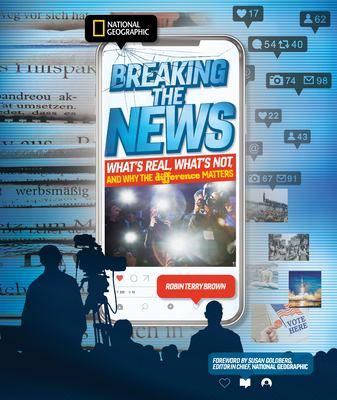
Breaking the news : what's real, what's not, and why the difference matters
A look at culture's relationship with journalism, and an effort to teach kids what is "real" versus "fake" news
Available Copies by Location
| Location | |
|---|---|
| Victoria | Available |
Browse Related Items
- ISBN: 9781426338885
- Physical Description 160 pages : illustrations ; 29 cm
- Publisher [Place of publication not identified] : [publisher not identified], 2020.
Content descriptions
| Bibliography, etc. Note: | Includes bibliographical references and index. |
| Formatted Contents Note: | The history of news -- Making the news -- Propaganda, half-truths, and hoaxes -- Media today -- Finding the truth -- The future of news -- Meet the experts -- Hilarious headlines & belly-busting bloopers. |
Additional Information

School Library Journal Review
Breaking the News : What's Real, What's Not, and Why the Difference Matters
School Library Journal
(c) Copyright Library Journals LLC, a wholly owned subsidiary of Media Source, Inc. No redistribution permitted.
Gr 6--9--News literacy is an important skill; students can find it difficult to gauge "fake news" and misinformation. Terry-Brown expertly breaks down why real news matters and how to become a more discerning consumer. The text describes the principles of journalism, why those principles matter, and how readers can use them to assess the validity of the information. Readers learn how to spot fake photos, bogus websites, and biased opinions. Propaganda and its historical uses are explained. Think viral hoaxes are a new thing? Not at all--several historical hoaxes that fooled many are detailed. Terry-Brown spends much (valuable) time showing readers how to evaluate sources, especially emphasizing the necessity of cross-checking information with multiple reputable sources. The information and back matter are rock-solid. However, the interior layout is busy. Photos, drawings, text boxes, off-set text, and multiple other distractions clutter the pages. VERDICT An excellent tool for teachers and librarians to use to explore the idea of information and media literacy. It's very unlikely that a middle schooler would pick up this title for an independent read, but every student (and adult) should know the principles within.--Lisa Crandall, formerly at the Capital Area Dist. Lib., Holt, MI

Kirkus Review
Breaking the News : What's Real, What's Not, and Why the Difference Matters
Kirkus Reviews
Copyright (c) Kirkus Reviews, used with permission.
The press: a great and powerful tool that preceded strokes of the pen and became mightier than any sword. With color-coded info boxes and brightly colored pages, Terry-Brown provides a sharp-looking survey that examines the history of news--how it began, how it evolved, and what consumers of all ages must consider before accepting a truth as the truth. Cool bits of history, funny hoaxes, and the scary reality of propaganda are packed in simple bites easy to absorb. For example, Terry-Brown reminds readers that back in ancient Rome, people gathered in town squares to learn the latest news, and gossip was widely accepted as fact. Compare that to the present day, 2,000 years hence, when the internet has become an accepted source of news and information, turning into the digital age's answer to the ancient town square. The author walks readers through the panorama of newsgathering, showing its evolution from spoken news to scribes providing written reports and then how Johannes Gutenberg put the scribes out of business. Later, radio and television made global news instant. One of the more fascinating and timely sections shows how the growing popularity and availability of televisions in the 1950s and '60s aided in the civil rights movement's call for justice for people of color. Excellent design and a clear narrative help readers navigate the vast and fast-changing concept of news. (timeline, glossary, sources, resources, bibliography, index) (Nonfiction. 10-16) Copyright (c) Kirkus Reviews, used with permission.


